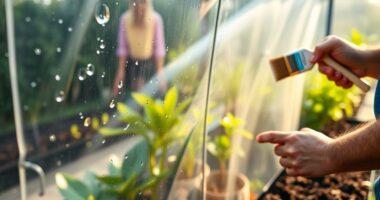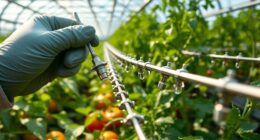Setting up an efficient greenhouse watering system starts with organizing your plants into zones based on their water needs. Use drip emitters for targeted watering and sprinkle heads for larger areas, ensuring proper coverage. Automate the process with timers and pressure regulators to maintain consistent moisture and avoid overwatering. Keep tubing and components organized for easy adjustments. If you’re interested in exploring how smart technology can further optimize watering, there’s more to discover ahead.
Key Takeaways
- Organize plants into zones based on water needs and install targeted drip emitters for efficient root zone watering.
- Use timers and pressure regulators to automate and optimize watering schedules, ensuring consistent moisture levels.
- Design system layout with accessible tubing and adjustable sprinkler heads for effective coverage and easy adjustments.
- Test and fine-tune emitters and spray angles to achieve uniform watering and prevent dry or overwatered spots.
- Incorporate AI and automation for schedule optimization, reducing manual effort and promoting healthy plant growth.

Are you ready to transform your garden into a lush, thriving oasis? The right irrigation setup makes all the difference in keeping your greenhouse plants healthy and vibrant. To start, you need a well-planned water distribution system that guarantees even coverage without wasting resources. Drip emitters are a game-changer here, allowing you to deliver water directly to each plant’s root zone. This targeted approach minimizes runoff and evaporation, making your watering more efficient. When setting up, consider the layout of your greenhouse and group plants with similar water needs together. This way, you can create distinct sprinkler zones tailored to different plant types and their moisture requirements. Sprinkler zones help you control water distribution more precisely, ensuring every section gets the right amount of moisture, whether you’re growing delicate seedlings or drought-tolerant succulents.
Connecting your drip emitters and sprinkler zones to a reliable water source is essential. Use timers to automate watering schedules, so your plants receive consistent hydration, even when you’re away. Automated systems not only save time but also prevent overwatering, which can lead to root rot and other issues. When designing your irrigation system, think about pressure regulation—install pressure regulators if needed, especially when using drip lines or multiple sprinkler zones. Proper pressure guarantees that emitters work correctly and that sprinklers distribute water evenly across their zones.
Automate watering with timers and pressure regulation for consistent, efficient greenhouse irrigation.
As you set up, pay attention to the layout of your tubing and wiring. Keep lines organized and accessible for easy adjustments or repairs. Position your emitters strategically, making sure each plant receives adequate water without oversaturation. For sprinkler zones, use adjustable heads to modify spray patterns and coverage areas. This flexibility guarantees your greenhouse stays uniformly watered, regardless of plant placement. Remember, the goal is to create a system that’s simple to operate but highly effective, reducing manual effort while maintaining ideal moisture levels.
Finally, don’t forget to test your setup thoroughly. Turn on your system and observe the coverage in each zone, checking for dry spots or overwatered areas. Make adjustments as needed, tweaking emitter placement or sprinkler angles for better results. Additionally, incorporating AI-powered data analysis can help optimize watering schedules based on weather patterns and plant needs, further enhancing efficiency. With a well-designed irrigation setup featuring drip emitters and carefully managed sprinkler zones, you’ll provide your plants with steady, efficient watering, fostering a healthy, productive greenhouse environment. This investment in a smart watering system ensures your plants thrive and your gardening efforts pay off in lush, vibrant growth.
Frequently Asked Questions
What Is the Best Water Pressure for Greenhouse Irrigation Systems?
You should aim for a water pressure between 20 and 30 PSI for your greenhouse irrigation system. This range guarantees efficient drip irrigation while preventing damage to emitters. Make sure to install proper water filtration to keep debris out of your system, maintaining consistent pressure and flow. Regularly check your pressure gauge and adjust as needed to keep your plants healthy and your system functioning smoothly.
How Often Should I Maintain My Greenhouse Watering System?
Think of your watering system as a garden’s heartbeat—constant care keeps everything thriving. You should perform watering system maintenance at least once a month, checking for clogs or leaks. Follow irrigation schedule tips to ensure plants get just the right amount of water. Regular maintenance prevents issues before they sprout, so stay vigilant and proactive. Your attention now fosters a healthy, flourishing greenhouse for seasons to come.
Can I Automate My Greenhouse Irrigation Setup?
Yes, you can automate your greenhouse irrigation setup with smart irrigation and drip automation. Installing a smart irrigation system allows you to schedule watering times, adjust based on weather conditions, and monitor soil moisture remotely. Drip automation guarantees precise watering directly to your plants’ roots, reducing water waste. This setup saves you time, promotes healthier plants, and keeps your greenhouse thriving with minimal manual effort.
Which Types of Emitters Are Most Efficient for Greenhouse Plants?
Drip emitters are generally the most efficient for greenhouse plants because they deliver water directly to the roots, minimizing waste and evaporation. Spray nozzles can be effective for foliar watering or cooling but tend to use more water overall. You should choose drip emitters for precision watering and conservation, especially for potted or bedded plants. Combining both types can optimize your system based on plant needs.
What Is the Average Cost to Install a Greenhouse Watering System?
On average, installing a greenhouse watering system costs between $500 and $2,000, depending on size and complexity. You should conduct a thorough cost analysis, considering your specific needs and budget. Explore various supplier options to find competitive prices and quality components. Remember, investing in a reliable system can save you money in the long run by ensuring efficient water delivery and reducing waste.
Conclusion
Now that you’ve got the basics of greenhouse watering systems down, you’re ready to nurture your plants like a seasoned gardener tending a delicate symphony. Remember, the right irrigation setup is the heartbeat of healthy, thriving plants. Keep tweaking and observing, and soon your garden will flourish as beautifully as a well-orchestrated masterpiece. With each drop of water, you’re planting the seeds for a lush, vibrant greenhouse to bloom all year round.








